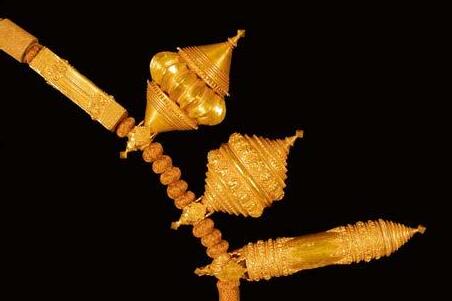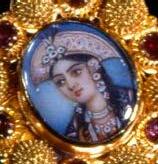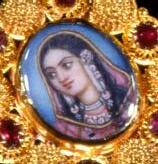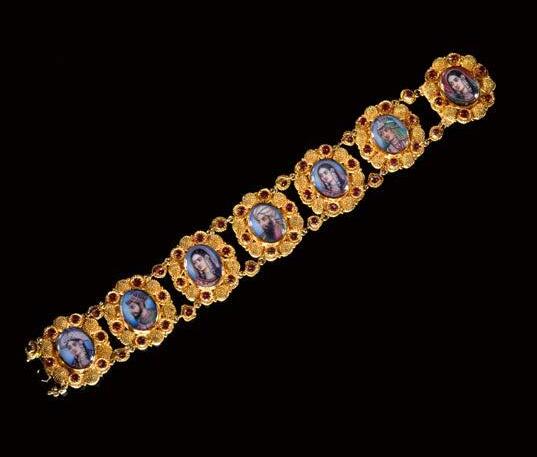

BEAUTIFUL PEOPLE
BERNADETTE VAN GELDER



Beautiful People
‘One needs to be an Indian woman, born and bred in the great tradition, to realize the sense of power that such jewels as earrings and anklets lend their wearers; she knows the full delight of swinging jewels touching her cheek at every step, and the fascination of the tinkling bells upon her anklets’
Ananda.K. Coomaraswamy
The Wisdom of Ananda Coomaraswamy: Reflections of Indian Art, Life, and Religion
Indian jewellery is inherently rooted in the spiritual depths. At one level, the ornamentation of the body is symbolic of an inner adorning. Ancient texts clearly state that a woman should always keep herself well adorned, it being necessary for the well-being of the entire household.
Being a woman in India means much more than just being female; a woman is the symbol of her family’s honour, and must adorn herself in a manner befitting her status. Her jewellery is an accessory of allure but is also a symbol of her marital status.
In India, jewellery is considered auspicious and beneficial, even the poorest will have some kind of jewellery. From simple brass, copper or silver anklets to the most extravagant pieces, all ornamentation expresses a natural yet sophisticated taste. Besides being decorative, jewels also serve as a means of insurance; a woman’s jewellery is her stree-dha (her wealth) and can be readily converted into cash should the need arise. The wearing of jewellery is also believed to be beneficial to good health; the weight of an earring, necklace, girdle or anklet, and the subtle pressure it exerts on the nerves promotes the well-being of the body’s internal organs.
The composite form used in jewellery symbolises Pancha Bhuta (the five great elements) which, according to Hinduism, are the basis of all cosmic creation. In Ayurveda and Indian philosophy, the human body is considered to be made of five elements:
1. prithvi, meaning ‘earth’ and symbolised by a square;
2. apas/jal, meaning ‘water’ and symbolised by a circle;
3. agni, meaning ‘fire’ and symbolised by a triangle;
4. vayu, meaning ‘air’ and symbolised by a crescent;
5. aakash, meaning ‘ether’ or sky and symbolised by a teardrop.
Amongst the five shapes, the prithvi square and the apas/jal circle are considered the most important. The circle represents the two celestial entities, the sun and the moon, and is the most often seen in jewellery designs.
Lady admiring her reflection in a mirror

Gold kalitiru, marriage necklaces
Tamil Nadu, Chettinad
Late nineteenth century
length of the larger necklace: 112 cm
weight of the larger necklace: 1,137 g
length of the shorter necklace: 90 cm
weight of the shorter necklace: 705.5 g

height of the thali of the longer necklace: approximately 13.5 cm
height of the thali of the shorter necklace: approximately 15 cm
height of each of the four finger-shaped pendants: approximately 12 cm
height of the three larger pendants of the larger necklace: approximately 11 cm and approximately 16 cm
A gold wedding ornament, spectacular in terms of scale, and formidable in symbolism. The kalutiru (from kaluthu meaning neck and uru meaning bead) consisting of two rows of pendant elements on a golden-yellow cord. A thali (pendant in the centre), richly decorated according to the family tradition, caste and region, is hanging down from the shorter upper necklace with five tubular beads on either side, and two larger tubular ornaments above, finely decorated with granulation and applied floral design. The thali is flanked by two hand shaped units, each with a cabochon ruby set in the centre, representing the hands of the bride.
This type of elaborate marriage jewellery is worn by brides from the Nattukottai Chettiar community. Parents present them to their daughters as part of their dowry jewellery. During the wedding ceremony, in front of the sacred fire, the groom ties the necklace around the bride’s neck.
The Nattukottai Chettiar is a wealthy prominent mercantile community with a very rich cultural heritage, known for building religious temples and schools throughout India. They worship Shiva and follow the belief system of Shaivism. They are considered the elite of all Chettiars and regarded as the most enterprising of all the trading communities in South India. In ancient times, and during the early years of the British regime, the Nattukottai Chettiars carried out the only form of organised banking. The term ‘Nattukkotai’ distinguishes them from other groups of Chettiars.
The term Chettiar is a title used by various mercantile castes in Tamil Nadu and Kerala in South India. Chettiar or Chetty derives from the Sanskrit word Shreshti, meaning ‘wealth’. They are related to other mercantile castes all over the subcontinent.
Further information:
Untracht, Traditional Jewelry of India, p.159 Jewels that Enchanted the World, pp.80, 81 Bala Krishnan and Kumar, Dance of the Peacock, p.148

Pair of gold bracelets
North India, Punjab
Late nineteenth century
weight, pair: 141 g length without cord: 13.5 cm
Thirteen stylised gold ‘birds’ set with rock crystal over red and green foil form this pair of bracelets. Three gold rings are soldered to each unit and strung on three original zari cords ending in one cord with a loop, embellished with a gold bead, and the other with a rosette button as terminal.
The bracelets are worn one on each wrist. Zari work is gold or silver wire with cotton.


Gold necklace set with diamonds
Bikaner
Nineteenth century
Gold necklace consisting of nine square plaques, each kundan-set with diamonds and a blue enamel roundel in the centre, bordered on top with three pearls and a tiny green-enamelled gold bead.
Suspended from each plaque are three fish-shaped pendants set with diamonds and fringes of pearls and emerald beads.
On the reverse, the pendants feature a white opaque enamel with peacocks, birds and flowers in red, green and blue enamel. The five-petal flower design in combination with a peacock with spread tail is traditional in the Bikaneri school.


Silver archer’s ring
North India
Early nineteenth century
A cast silver-enamelled archer’s thumb ring with peacock-blue (gardan-e-talus) enamel on the front in champlevé technique. The concave reverse has a similar decoration. The top and bottom edges are defined by a thin line of blue enamel.
Further information:
Keene and Kaoukji, Treasury of the World, p.65 Untracht, Traditional Jewelry of India, pp.267, 268 Jaffer, Beyond Extravagance, p.186, illustrations 50, 51



Gold pendant
North India, Bengal, Murshidabad
Eighteenth/nineteenth century
height: 3.8 cm
width: 3.3 cm weight: 22 g
Front
Gold pendant with a double crescent. The lower crescent is kundan-set with foiled faceted rubies, the upper crescent is kundan-set with foiled chakri-cut diamonds. In the centre is a foiled cabochon emerald below a sun-motif decoration, also set with diamonds and rubies. Seven oval-shaped beads set with cabochon rubies form the edge to the pendant.
Reverse
The reverse is decorated with red, green, white and dark-blue enamel on a gold ground, depicting a galloping horse and a peacock with a bird on either side, surrounded by a formal floral design.


Gold guluband, necklace
Uttar Pradesh, Benares ( Varanasi) Eighteenth century
Gold necklace (guluband) consisting of twenty-four units attached to a centrepiece and crowned with pearls decorated with small, green glass beads. The whole is kundan-set with flat- and rose-cut diamonds.
Leaf-shaped pendants set with diamonds and fringes of pearls and green glass beads are attached to each unit.
The sides of the small pendants and the links show traces of green (sabz zamin) enamel.
The reverse of the necklace shows the delicate gulabi enamel, chased and engraved champlevé on a gold base with pink- and bluepainted enamel on opaque white. Some traces of translucent green and yellow enamel are still visible, as is the light-blue enamel on the gold links.
Only in the eighteenth century was the enamel tradition developed by Punjabis in Benares and Lucknow
Further information: Babur’s Heritage, p.70 Brunel, Jewellery of India, plate 54


Timaniya, necklace
Rajasthan, Bikaner
Late nineteenth/early twentieth century
Timaniya consisting of a rigid gold centrepiece with an intricate design and jhaller. The whole is kundan-set with faceted and foiled colourless rock crystal (billore) six cabochon rubies and six emeralds. Attached to the upper part are three rows of fish-shaped gold pendants with a single fish-shaped pendant below. All pendants are decorated with bunches of pearls and green glass beads. The timaniya is suspended from multiple strands of white glass beads.
The reverse of the timaniya shows a fine-hammered mirror image of the floral and fish motifs from the front.
Timaniya with jhaller is a traditional Bikaneri marriage design that is given to the bride by the groom. The fish (matsya) symbolises the first incarnation of Lord Vishnu and is often seen as a symbol of fertility.










Gold bracelet
Miniatures: North India
Nineteenth century
Gold framework: Bengal
Nineteenth century
Gold bracelet consisting of seven hinged frameworks accommodating miniature portraits on ivory.
These typical Bengali frameworks are each set with six rubies, and the rosette-shaped links are each set with a single ruby. The five miniatures show Mughal begams (ladies of the court). The miniature on the far left is probably Arjumand Banu, known as Mumtaz Mahal (1593–1631), wearing a fan-shaped cap. Next to her is Emperor Shah Jahan (1592–1666) and a portrait of a male figure from the Mughal past sits in the centre.
In general, portraits of Mughal ladies of the court were idealised because these women lived in the zenana (women’s quarters), where they led entirely secluded lives and were almost never seen in public.
Further information: Untracht, Traditional Jewelry of India, p.380, illustration 823

